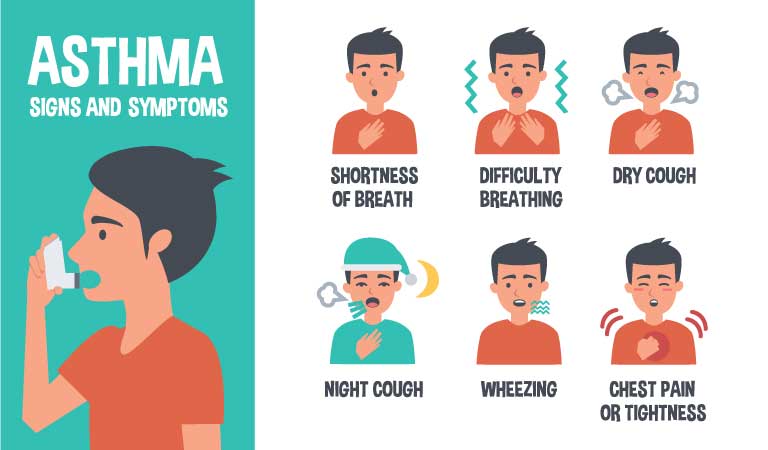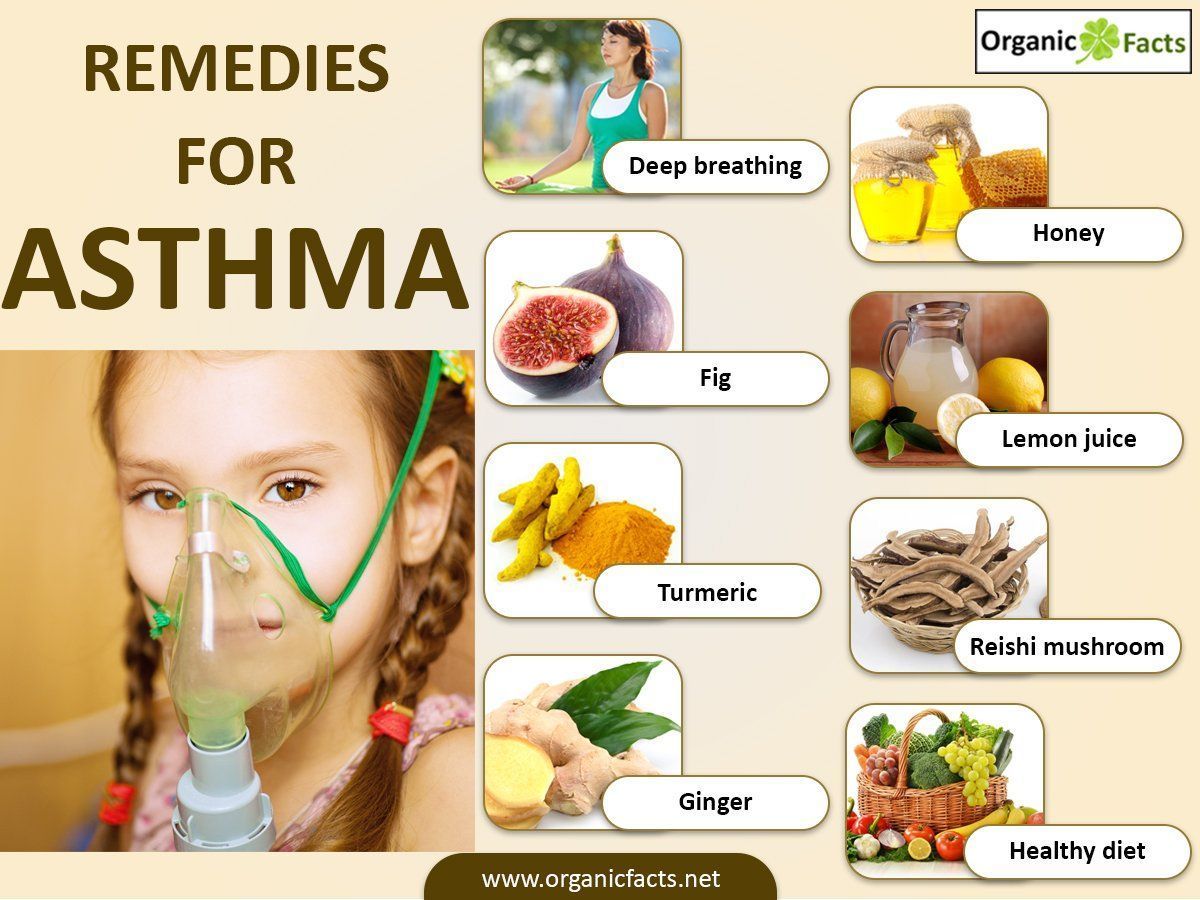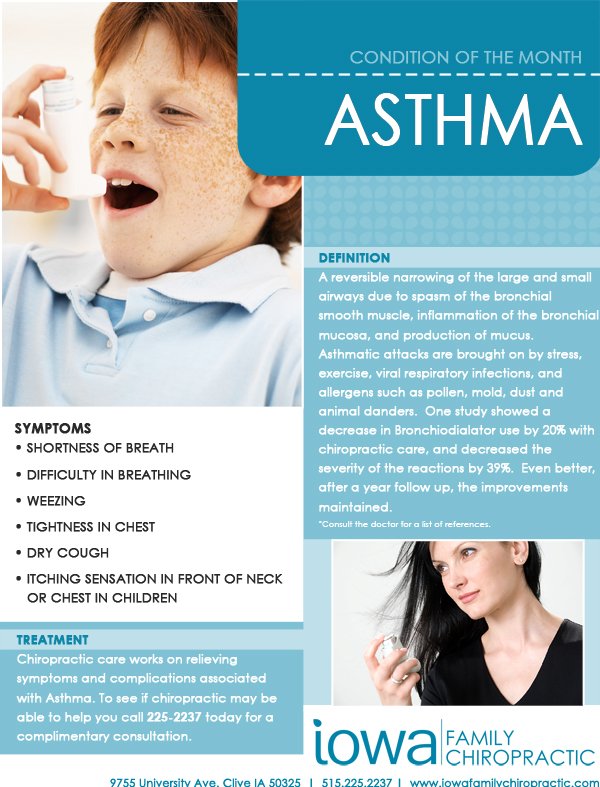What Is Childhood Asthma
Asthma is a condition that affects the airways and the small tubes that carry air in and out of the lungs. Childhood asthma is not a different disease than asthma in adults, but children face bothersome symptoms that interfere with their daily activities including play, sports, school and sleep.
The word asthma is derived from a Greek word meaning âbreathlessness or pantingâ both of which accurately describe an attack of asthma.
In children with asthma, airways are swollen and inflamed. When these inflamed airways come into contact with an asthma trigger, symptoms of asthma appear.
Asthma has multiple causes, and two or more different causes can be present in one child. Colds and allergens are the two most common factors that trigger an asthma attack. Coughing, recurrent bronchitis, wheezing and shortness of breath, especially during exercising can be seen in an asthmatic child.
Based on the severity of the symptoms, childhood asthma can be classified as:
- Mildâ Cough or a wheeze is present, but the child plays happily and feeds well. Sleep is undisturbed by symptoms.
- Moderateâ The child wakes up at night and cannot run around and play without wheezing or cough.
- Severeâ The child is too restless to sleep, unwilling to play at all, too breathless to talk or feed.
There is no particular diagnostic test and asthma is diagnosed with the help of medical history, symptom evaluation and physical examination.
- Furry feathery animals/ pets/ toys
- House dust mite
Will I Have To Take Medicine All The Time
Maybe not. Asthma is a chronic condition that is controllable. Unfortunately, there is no cure for asthma. For that reason, you may have asthma symptoms when exposed to triggers. This is the case even if you dont have symptoms very often. Your triggers can change over time, and your treatment will depend on two things: how severe your asthma is, and how often you have symptoms. If your asthma is controlled, your treatment will focus on managing symptoms and treatment of episodes when they happen.
If your symptoms happen at certain times and you know what caused them, you and your doctor can use this information to determine the best treatment. If, for example, you have seasonal asthma because of a specific pollen allergy, you may take medicines only when that pollen is in the air. But asthma that specific is not common. Many people with asthma take some form of medicine most or all of the time.
Types Of Severe Asthma
There are two main categories of severe asthma Type-2 inflammation and Non-Type-2 inflammation. These categories are based on a persons response to treatment. Type-2 inflammation includes allergic asthma and eosinophilic asthma and Non-Type-2 inflammation includes non-eosinophilic asthma. For example, allergic asthma and e-asthma respond to treatment with inhaled corticosteroids and IgE -directed therapy or other biologics listed in the above table. Patients with Non-Type-2 inflammation, including non-eosinophilic asthma, generally do not respond well to inhaled corticosteroids. Allergic asthma and e-asthma have distinct biomarkers and treatment options available today. Treatments for non-eosinophilic asthma are currently being development.
Allergic asthma is caused by exposure to allergens such as pollen, pet dander, molds, etc. Most people diagnosed with allergic asthma will also have a diagnosis of hay fever or rhinitis. For these patients, exposure to allergens causes the bodys immune system to produce immunoglobulin E, an antibody that attaches to certain cells and causes them to release chemicals creating an allergic reaction. When this happens, common symptoms are sneezing, itchy/watery eyes, severe allergic reactions , and increased airway sensitivity.
Non-eosinophilic asthma includes neutrophilic, smooth-muscle mediated and mixed cells. People in this subgroup have few to no eosinophils in test results, and do not respond well to inhaled corticosteroids.
Recommended Reading: How To Stop Wheezing Without An Inhaler
What You Need To Know About Albuterol
Before realizing what was going on with Lucas, he was prescribed albuterol. He didnt respond well to it. Each time he takes it, his 02 drops for over an hour afterward. I saw this both on the pulsox we have at home and when he has admitted to the hospital with pneumonia two and a half years ago. I finally asked the hospital staff to stop the treatments as I felt that they were making him worse. The nurses informed me that I was not the only parent to see this and to request it be stopped.
Also Check: How Do People Control Their Asthma
How Do You Take Asthma Medications

Asthma inhalers
Asthma inhalers are the most common and effective way to deliver asthma medicine to your lungs. Theyâre available in several types that work in different ways. Some deliver one medication. Others contain two medications. Your doctor might give you:
- A metered-dose inhaler, which uses a small aerosol canister to push out a short burst of medication through a plastic mouthpiece
- A dry powder inhaler, which releases the medicine only when you take a deep breath
Asthma nebulizer
If youâre having trouble using small inhalers, your doctor may recommend a nebulizer. This machine changes asthma medications from a liquid to a mist so itâs easier to get the medicine into your lungs. It also has a mouthpiece or mask that makes it a good option for infants, small children, older adults, or anyone who has trouble using inhalers with spacers. It takes a few more minutes to use than an inhaler.
Read Also: How To Calm Down Asthma Symptoms
Can Asthma Be Cured
Most people with asthma are able to control their condition if they work together with a health care provider and follow their treatment regimen carefully.
People who do not seek medical care or do not follow an appropriate treatment plan are likely to experience worsening of their asthma and deterioration in their ability to function normally.
How Do You Monitor Asthma Symptoms
Monitoring your asthma symptoms is an essential piece of managing the disease. Your healthcare provider may have you use a peak flow meter. This device measures how fast you can blow air out of your lungs. It can help your provider make adjustments to your medication. It also tells you if your symptoms are getting worse.
Recommended Reading: Elevated Ige And Eosinophils
What Causes Asthma In Infants And Toddlers
We still do not know what causes some people to get asthma. If a child has a family history of asthma or allergies, a specific allergy or had a mother who smoked during pregnancy, they have a higher chance of getting asthma early in life.
A respiratory virus, an illness that occurs in the lungs, is one of the most common causes of asthma symptoms in children 5 years old and younger. Although both adults and children experience respiratory infections, children have more of them. Some preschool children get viral infections often. At least half of children with asthma show some sign of it before the age of 5. Viruses are the most common cause of acute asthma episodes in infants 6 months old or younger.
Asthma Triggers And Inducers Can Work In Combination
Keep in mind, asthma triggers and inducers can work in combination. For example, if your airways are already swollen because you have a viral infection, and then you go into a smoky room, your airways are less able that usual to cope with the smoke. The inducer and the trigger gang up to make your asthma worse.
You May Like: Does Asthma Shorten Life Expectancy
Asthma Patterns In Children
Every childs asthma is different. Some children have mild, occasional episodes of asthma or only show symptoms after exercising, or when they have a cold. Some experience daily symptoms, while others have symptoms continuously, which limit their level of activity.
Each pattern of asthma requires a different treatment approach. It is important to remember that children can still have a severe and even life-threatening attack, even if they generally have mild or occasional asthma.
How To Spot And Treat Feline Asthma
This article was co-authored by Lauren Baker, DVM, PhD. Dr. Baker is a Veterinarian and PhD candidate in Comparative Biomedical Sciences. Dr. Baker received her Doctor of Veterinary Medicine from the University of Wisconsin in 2016, and went on to pursue a PhD through her work in the Comparative Orthopaedic Research Laboratory. This article has been viewed 10,697 times.
Feline asthma is a chronic swelling and irritation of a feline’s airway. In severe cases, the condition can be fatal and should be treated as soon as possible. Spotting asthma in felines requires that you assess the cat’s general health and look for signs that it is having trouble breathing. Once you suspect that your cat may have asthma, you should have it looked at by a veterinarian and begin treatment. With a little bit of effort on your part, and with the help of your veterinarian, you can spot and treat asthma in your cat.
You May Like: Does Weight Gain Make Asthma Worse
How To Prevent Feline Asthma Attacks
Once your cat is diagnosed with feline asthma, you have several options for lifestyle changes that can help reduce recurring asthma attacks, depending on the severity of the case. The first and most obvious thing you’ll need to do is to try to eliminate the environmental allergens that are causing respiratory distress in your cat. Some will be easy others more complicated or expensive. Some of the most common triggers of feline asthma include:
How Do You Treat Asthma In Your Practice

Medical Acupunctureis pleased to continue this regular feature,Clinical Pearls,which we have found to be very useful for, and practical to the readership, and very popular. All of us are confronted with clinical challenges, especially when dealing with therapeutic strategies. We hope this ongoing collection of Clinical Pearls will be easily accessible and ready to put into action for the benefit of our patients, and even ourselves. How often do we ask our colleagues: How do you treat ? This time, we posed the question:How do you treat Asthma in your practice?Herein lie your contributions. We trust that our readership will continue to participate in this section by either asking the questions or supplying the Pearls. If you have a question you would like to see answered, please send it to our managing editor,We encourage and welcome your input and participation. Please address your answers to Pearls to our managing editor,Poovadan Sudhakaran, MBBS, PhDMastACU, MastTCM26 Tuckers RoadTemplestowe 3106
Asthma, from the Greek word Aazein, means to pant.Corpus Hippocraticum is the earliest text where asthma is found as a medical term.
In 2015, 358 million people globally had asthma. About 25 million Americans have asthma. This is 7.6% of adults and 8.4% of children. It is more common in boys than in girls. Prevalence of asthma is more common among Puerto Rican patients than among any other ethnic group.
Recommended Reading: What To Do If Someone Has An Asthma Attack Without Inhaler
Natural Asthma Remedy Risks
As you consider the different types of natural asthma remedies, itâs very important to carefully balance your desire to breathe easier with the possible dangers of the treatments, which may be unknown. Keep these things in mind:
- Never use any dietary supplement before checking with your doctor.
- Some natural herbal products, such as bee pollen, may trigger an asthma attack if youâre allergic to the specific plant.
- Never stop using your asthma drugs without your doctorâs knowledge. If you donât follow your treatment plan, the results can be very serious and even deadly.
If youâre not sure about the claims on a natural dietary supplement product label, call your doctor before taking it. They can check the product to let you know if it has any health benefits.
What Types Of Asthma Are There
Healthcare providers identify asthma as intermittent or persistent . Persistent asthma can be mild, moderate or severe. Healthcare providers base asthma severity on how often you have attacks. They also consider how well you can do things during an attack.
Asthma can be:
- Allergic: Some peoples allergies can cause an asthma attack. Molds, pollens and other allergens can cause an attack.
- Non-allergic: Outside factors can cause asthma to flare up. Exercise, stress, illness and weather may cause a flare.
Recommended Reading: How To Calm Down Asthma Symptoms
Other Medication And Asthma Triggers
Some medication for other health conditions can make asthma symptoms worse and trigger an asthma flare-up or attack.
It is very important that you inform your doctor and pharmacist that you have asthma when a new medicine is prescribed to you or when you are buying over-the-counter medication or complementary therapies.
If you feel a particular medicine is making your asthma worse, treat your symptoms and contact your doctor immediately.Some medicines known to trigger asthma symptoms in some people include:
- aspirin contained in some medication, such as pain relievers
- non-steroidal anti-inflammatory drugs such as ibuprofen and naproxen
- beta-blocker tablets often used to control high blood pressure
- beta-blocker eye drops to treat the eye condition glaucoma
- ace inhibitors often used to control high blood pressure.
Contents Of An Asthma Action Plan
An asthma action plan includes:
- how to care for your day-to-day asthma
- key things that tell you when your asthma is getting worse or a flare-up is developing, and the steps you should take to manage it
- symptoms that are serious enough to need urgent medical help .
Review your asthma action plan with your doctor every 6 months, or after a severe asthma flare-up.
Read Also: Does Weight Gain Make Asthma Worse
What Are The Signs And Symptoms Of Asthma Types
Symptoms may occur during the day or at night. If they happen at night, they may disturb your sleep.
Wheezing is the most common symptom of an asthma attack.
Current guidelines for the care of people with asthma include classifying the severity of asthma symptoms, as follows:
The exact cause of asthma is not known.
Three Natural Therapies For Childhood Asthma
For parents of asthmatic children, the night can be a stressful time. Just the sound of normal snoring can set internal alarm bells ringing. Jumping out of bed, parents may check on their kids countless times through the night, albuterol inhalers at the ready. Needless to say, its not a recipe for sound sleep. Although inhaled albuterol and steroids are lifesaving, can control symptoms, and are an important part of an asthma action plan, we need treatment options that heal the lungs over time. In the realm of natural medicine, there are a number of remedies that show promise. In particular, three treatments stand out in the research: glutathione, quercetin, and magnesium. Each of these therapies target the physiologic changes that take place with chronic asthma.
Recommended Reading: How Long Can Someone With Asthma Hold Their Breath
You May Like: How To Get Rid Of Asthma Without Inhaler
Who Can Get Asthma
Anyone can develop asthma at any age. People with allergies or people exposed to tobacco smoke and secondhand smoke are more likely to develop asthma.
Statistics show women tend to have asthma more than men, and asthma affects Black Americans more frequently than other races.
When a child develops asthma, healthcare providers call it childhood asthma. If it develops later in life, its adult-onset asthma.
Children do not outgrow asthma. They may have fewer symptoms as they get older, but they could still have an asthma attack. Your childs healthcare provider can help you understand the risks.
Southern Cross Medical Library

The purpose of the Southern Cross Medical Library is to provide information of a general nature to help you better understand certain medical conditions. Always seek specific medical advice for treatment appropriate to you. This information is not intended to relate specifically to insurance or healthcare services provided by Southern Cross. For more articles go to the Medical Library index page.
You May Like: Does Weed Cure Asthma
Are There Natural Remedies For Asthma Attacks
The typical treatment for an asthma attack is a quick-acting inhaler with medication. Sit upright and take slow, steady breaths. Try to stay calm. Follow the asthma action plan that youâve set up with your doctor. If your breathing doesnât get better or if youâre so short of breath that you canât talk, get medical help right away.
Some breathing exercises can help with symptoms of an asthma attack.
- Pursed-lip breathing. This slows your breathing and helps hold your airways open longer so your lungs work better. With your mouth closed, breathe in slowly through your nose. Then breathe out through your mouth, with your lips pursed like youâre whistling, for twice as long.
- Belly breathing. This technique uses the same steps as pursed-lip breathing. But as you breathe in, focus on the movement of your belly. Picture it filling with air like a balloon. It may help to keep your hands on your belly so you can concentrate on the air going in and out.
